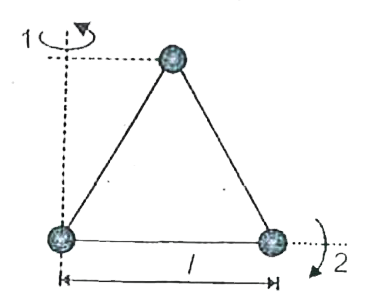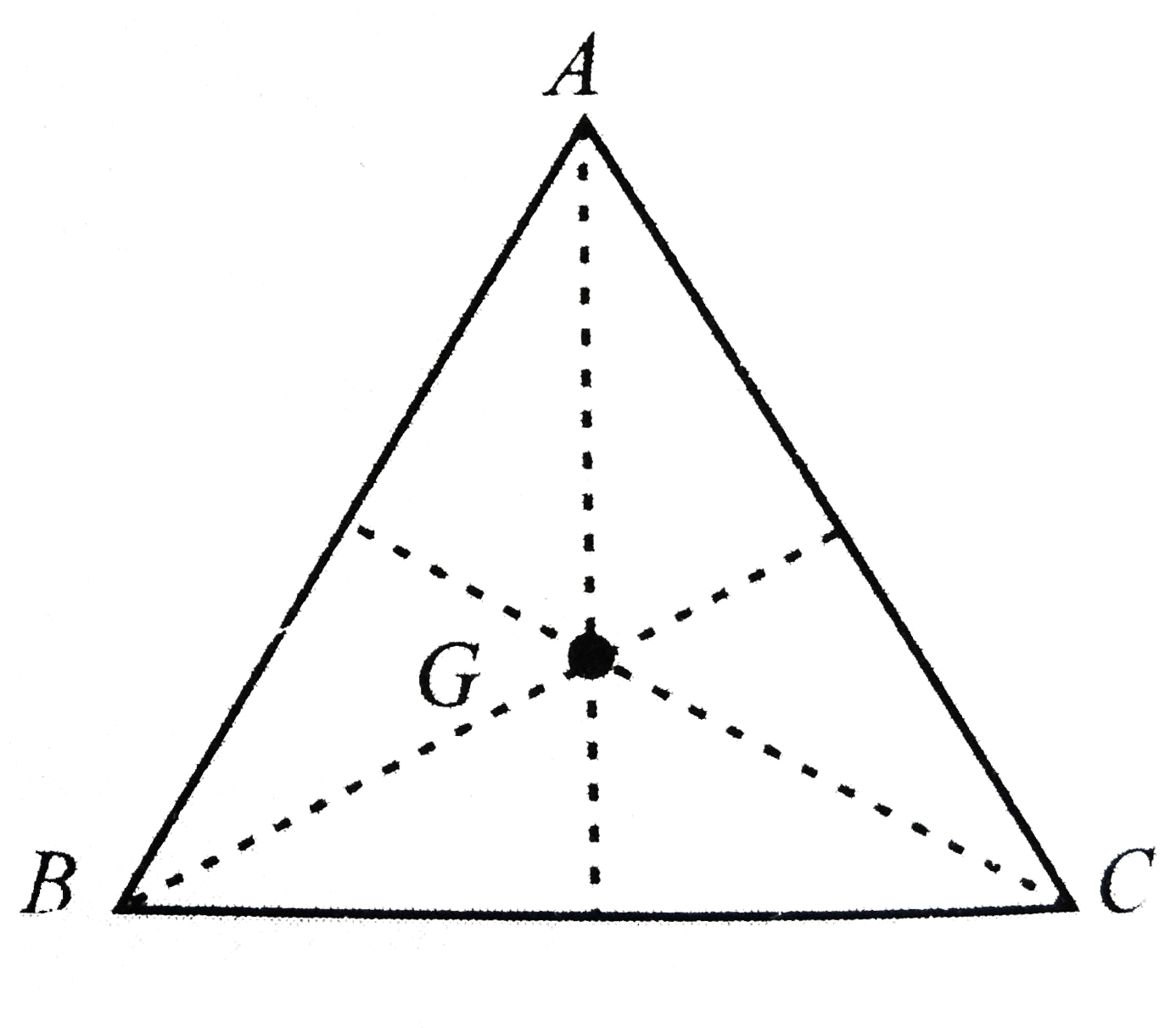Three equal masses each of mass 'm' are palced at the three corners of an equilateral of side a
If a fourth particle of equal mass is placed at the centre of triangle then net force acting on it is equal to .
Gm2a2
4Gm23a2
3Gm2a2
zero
The correct Answer is:B
To solve the problem, we need to determine the net gravitational force acting on a mass placed at the center of an equilateral triangle formed by three other equal masses at its corners.
1. Understanding the Setup:
We have three equal masses (each of mass 'm') placed at the vertices of an equilateral triangle with side length 'a'. A fourth mass (also of mass 'm') is placed at the center of the triangle.
2. Finding the Distance from the Center to the Vertices:
The distance from the center of the triangle to any vertex can be calculated using geometry. For an equilateral triangle, this distance (let's call it 'r') can be derived as:
r=a√3
This is derived from the properties of the triangle and using the cosine of 30 degrees.
3. Calculating the Gravitational Field Due to One Mass:
The gravitational field (E) at the center due to one of the masses at the vertex is given by:
E=G⋅mr2
Substituting 'r' from the previous step:
E=G⋅m(a√3)2=G⋅m⋅3a2=3Gma2
4. Direction of the Gravitational Fields:
The gravitational field due to each of the three masses acts towards the respective mass. Since the triangle is symmetric, the components of the gravitational fields in the horizontal direction will cancel out.
5. Resolving the Gravitational Fields:
Each gravitational field can be resolved into two components (vertical and horizontal). The horizontal components will cancel each other out due to symmetry, while the vertical components will add up. The vertical component of the gravitational field from each mass is:
Evertical=E⋅cos(60∘)=E⋅12
Therefore, the total vertical component from all three masses is:
Enet=3⋅E⋅12=3E2
6. Calculating the Net Gravitational Force:
The net gravitational force acting on the mass at the center is given by:
Fnet=m⋅Enet
Substituting for E:
Fnet=m⋅3⋅3Gma22=9Gm22a2
7. Conclusion:
The net gravitational force acting on the mass placed at the center of the triangle is:
Fnet=9Gm22a2
Final Answer:
The net force acting on the mass at the center of the triangle is 9Gm22a2.
---
We have three equal masses (each of mass 'm') placed at the vertices of an equilateral triangle with side length 'a'. A fourth mass (also of mass 'm') is placed at the center of the triangle.
The distance from the center of the triangle to any vertex can be calculated using geometry. For an equilateral triangle, this distance (let's call it 'r') can be derived as:
r=a√3
This is derived from the properties of the triangle and using the cosine of 30 degrees.
The gravitational field (E) at the center due to one of the masses at the vertex is given by:
E=G⋅mr2
Substituting 'r' from the previous step:
E=G⋅m(a√3)2=G⋅m⋅3a2=3Gma2
The gravitational field due to each of the three masses acts towards the respective mass. Since the triangle is symmetric, the components of the gravitational fields in the horizontal direction will cancel out.
Each gravitational field can be resolved into two components (vertical and horizontal). The horizontal components will cancel each other out due to symmetry, while the vertical components will add up. The vertical component of the gravitational field from each mass is:
Evertical=E⋅cos(60∘)=E⋅12
Therefore, the total vertical component from all three masses is:
Enet=3⋅E⋅12=3E2
The net gravitational force acting on the mass at the center is given by:
Fnet=m⋅Enet
Substituting for E:
Fnet=m⋅3⋅3Gma22=9Gm22a2
The net gravitational force acting on the mass placed at the center of the triangle is:
Fnet=9Gm22a2
The net force acting on the mass at the center of the triangle is 9Gm22a2.
Topper's Solved these Questions
Similar Questions
Three equal masses each of mass 'm' are placed at the three-corner of an equilateral triangle of side 'a'
If a fourth particle of equal mass is placed at the centre of triangle, then net force acting on it, is equal to
View SolutionThree equal masses m are placed at the three corners of an equilateral triangle of side a. The force exerted by this system on another particle of mass m placed at the mid-point of a side.
View Solution
Knowledge Check
Three masses each of mass m are palced at the vertices of an equilateral triangles ABC of side l as shown in figure. The force acting on a mass 2m placed at the centroid O of the triangle is
 AzeroB3Gm2l2C5Gm2l2D7Gm2l2
AzeroB3Gm2l2C5Gm2l2D7Gm2l2
Three particle each of mass m are placed at the corners of equilateral triangle of side l

Which of the following is/are correct ?
View SolutionThree equal masses each of mass 'm' are placed at the three-corner of an equilateral triangle of side 'a'
In the above system, if two particles are kept fixed and third particle is released, then speed of the particle when it reaches to the mid point of the side connectiong other two masses is
View SolutionThree masses, each equal to M, are placed at the three corners of a square of side a. the force of attraction on unit mass at the fourth corner will be
View SolutionThree equal masses m are placed at the three corners of an equilateral triangle of side a. find the force exerted by this system on another particle of mass m placed at (a) the mid point of a side (b) at the center of the triangle.
View SolutionThree equal masses of 1.5 kg each are fixed at the vertices of an equilateral triangle of side 1 m. What is the force acting on a particle of mass 1 kg placed at its centroid ?
View SolutionThree equal masses of 1 kg each are placed at the vertices of an equilateral triangle and other particle of mass 2kg is placed on centroid of triangle which is at a distance of √2 m from each of the vertices of the triangle .The force in newton , acting on the particle of mass 2 kg is
View SolutionThree equal masses of mkg each are fixed at the vertices of an equilateral triangle ABC.
a. What is the force acting on a mass 2m placed at the centroid G of the triangle?
b. What is the force if the mass at the vertex A is doubled? Take AG=BG=CG=1m

View Solution
